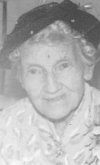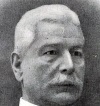
Emma Aldridge.
A most remarkable woman
Emily Helen (or Ellen) Sophia Aldridge (1876-1970) married Harry Coker and had eight children who survived to adulthood.
The couple adopted out to Emily’s sister Elizabeth Dobbs (nee Aldridge), their son John Alexis.
He was the survivor of twins that left Emily dangerously ill and Elizabeth cared for the baby while her sister recovered.
Emily (known as Emma) had a leg amputated as a child (see more below) while the Aldridge family lived in England for several years.
She became adept at getting around with one crutch and more than one of her children spoke about the speed with which she could catch up with them and mete out punishment when needed.
The late Cyril Coker recalls trying to hide from his mother under a bed and being hooked and dragged out from what he thought was a safe place.
The following is an extract from the e-publication I’ll Show You Gold which is available through Amazon. I wrote the story of Henry Aldridge’s life based on his hand-written memoirs:
Edmund Owen looked at the slip of a girl, considered for a moment the agony she was in but knew his decision could only be to amputate her leg.
Her knee joint was gangrenous.
He had listened to her anxious yet fiercely determined parents and sensed in the father that he was dealing with a self-made individual.
“If she’s like him,” Edmund thought, “maybe she’ll survive but I doubt it.”
The family was from Hertfordshire just north of London but something about Henry Aldridge’s rugged appearance and the certainty of his ways told Edmund that he’d experienced life on a different level to most of the parents he dealt with.
An associate mentioned something about Australia.
Emma was small even for an eight-year-old but in a decade of operating at London’s Great Ormond Street Children’s Hospital, Edmund Owen had seen youngsters far more robust than the one on the table before him die from less serious conditions.
He’d had successes and failures and often wondered what medical advances would occur in the coming decades that would make a doctor’s task easier and increase the chances of survival of the children they treated.
“Maybe so many of them won’t have to die,” he thought. “Maybe by the end of the century I’ll be looking back at a defining time in medical science.” He snapped back to reality. “Why didn’t this little one say anything about the pain she was in?”
“She and her sister Lizzie were running and Emma hit herself on the hearth,” her mother explained.
Edmund nodded as Harriett absent-mindedly continued: “Lizzie said Emma would run and play with her hoop and the pain wouldn’t be so bad.”
“The leg will have to come off,” Henry stated blandly. “Otherwise she will die.”
“Yes,” said Edmund a little shocked that the father didn’t even phrase a question.
He didn’t have to explain the operation and sensed Henry and Harriett already knew what would happen.
No time to waste.
The chloroform administered, Edmund quickly sawed through Emma’s tiny thigh and covered the stump with carbolic gauze.
Only time would tell now.

Edmund Owen. University of Sheffield image.
Later, Edmund wrote out the case notes: “Emma Aldridge, of 1 Codicote Road, Welwyn, Hertfordshire, was admitted on Wednesday, May 6, 1885, aged eight and a half.
Treated for necrosis of the upper end of the tibia. Treatment involved amputation of the middle third of thigh.”
Several months later, Edmund was mildly surprised but pleased to add: “In November a conical piece of bone separated from end of stump, after which stump healed up”.
“That she survived to this point is a wonderful thing,” Edmund said to himself.
As Henry and Harriett took their daughter home, Edmund even dared to believe that, one day, little Emma may have children of her own.
For now, though, the Aldridge family had to deal with one of their four children being disabled for life.
But she had a life and who knows what sort of life that would be?
